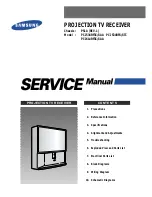
Storage
Dräger WorkMaster Industry
23
If the pressure change is less than 1 mbar, the suit valve is OK.
In this case:
1. Disassemble test setup.
2. Fit the protective cap onto the suit valve.
If the pressure change is greater than 1 mbar:
1. Remove the valve disc and conduct a visual inspection.
The valve disc and valve seat must be clean and
undamaged.
2. If necessary, replace valve disc (see Chap. 6.7.3 on
Page 23).
3. Repeat the test.
6.7
Special maintenance work
We recommend that all repairs be conducted by Dräger.
6.7.1
Replacing gloves
Always replace gloves as follows:
1. Pull off overgloves and rubber ring (if available).
2. Use your thumb to lift the edge of the arm ring and push the
support ring on which the glove is fitted out of the sleeve.
3. Pull the new glove onto the support ring and align with the
arm ring. The long axis of the elliptic support ring points
parallel to the palm.
Make sure that there are no creases between glove and
support ring.
4. Insert the glove with the support ring through the open
fastener system into the chemical protection suit sleeve.
5. Put the glove with the support ring through the arm ring:
the left glove goes into the left sleeve, and the right into
the right sleeve.
The back of the hand points to the seam of the sleeve.
6. Push the glove and support ring into the arm ring until the
edge of the support ring touches the edge of the arm ring.
The support ring must fit completely into the arm ring
recess.
7. Fit the overglove (if desired):
Pull the K-MEX
®
Gigant overglove over the arm ring.
Pull the Tricotril
®
overgloves over the arm ring and
secure with the corresponding rubber ring.
8. Check the seal on the chemical protective suit (see
Chap. 6.5 on Page 22).
6.7.2
Replace protective boots
1. To facilitate this task, turn the chemical protection suit with
the protective boots inside out.
2. Fold the protective strips over and unfasten the old metal
clamp with a suitable tool.
3. Carefully remove the old metal clamp and protective strips
from the protective boot, making sure not to damage the
suit material.
4. Remove the protective boot.
5. Remove old casting compound from the suit material.
6. Position the new support ring flush with the upper edge in
the new protective boot.
7. Fit the new protective boot with the support ring into the
chemical protection suit leg, leaving the material to
protrude approx. 1 cm. The leg seam must be on the inside
of the boot.
8. Align the metal clamp with the protective strip approx. 1 cm
below the upper edge of the protective boot. Make sure
that the screw thread of the metal clamp is positioned at the
back of the boot and the protective strip points to the sole.
9. Carefully fasten the metal clamp.
10. Tighten the screw thread making sure that the suit material
doesn't shift or get damaged.
11. Put on disposable gloves if necessary.
12. Stick foam rubber onto the protective strip to cover the
metal clamp screw thread. If necessary use 2 pieces of
foam rubber.
13. Use the sealing compound to completely seal the
protective boot between suit material and boot outside in
one continuous uninterrupted motion.
14. Make sure that no air gap is left.
15. Ensure that the sealing compound projects towards the
inner centre of the boot without running into the boot.
16. Carefully wipe excess sealing compound off with a cloth.
17. Wait at least 24 hours for the sealing compound to cure.
18. After curing, fold the protective strip over the screw thread
and turn the chemical protection suit leg back inside out.
19. Check the seal on the chemical protective suit (see
Chap. 6.5 on Page 22).
6.7.3
Replacing a valve disc
1. Unfasten protective cap and old valve disc. Do not damage
the valve housing plug.
2. Fit a new valve disc.
3. Place the protective cap onto the training suit.
4. Check the seal on the suit valve (see Chap. 6.6 on
Page 22).
6.7.4
Replacing the suit valve
1. Unbutton the protective cap of the suit valve.
2. Unscrew the threaded ring with the pin spanner from the
inside.
3. Pull off slip ring and sealing and dismantle the damaged
valve seat.
4. Fit the new valve seat, gasket and slip ring.
5. Fit a new valve disc.
6. Check the seal on the chemical protective suit and on the
suit valve (see Chap. 6.5 on Page 22 and Chap. 6.6 on
Page 22).
7. Refit the protective cap after the leakage test was passed.
7
Storage
1. Close the fastener system up to approx. 5 cm before the
end. Regularly check whether the fastener system is still
adequately greased.
2. Pull the flat bag supplied over the hood.
3. If the chemical protective suit is folded together, pull the
supplied flat bag over the safety boots so that the chemical
protective suit is not discoloured.
WARNING
Do not use talcum for fitting the gloves. Otherwise the
gloves may slip out if the user exerts too much
pressure on the glove from inside by stretching too
much.
!
CAUTION
If you fail to ensure proper storage conditions, the
chemical protective suit may be damaged!
!
















































